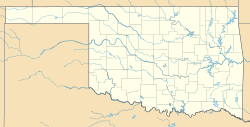Merchants National Bank Building facts for kids
Quick facts for kids |
|
|
Merchants National Bank Building
|
|
| Location | SW corner of Main and Railway Sts., Lehigh, Oklahoma |
|---|---|
| Area | less than one acre |
| Built | 1907 |
| Built by | Faudree Brothers |
| Architectural style | Late Victorian Renaissance |
| NRHP reference No. | 06001112 |
| Added to NRHP | December 6, 2006 |
The Merchants National Bank Building is an old, two-story brick building in Lehigh, Oklahoma. It stands at the corner of Main Street and Railway Street. This building was one of only two banks that helped Lehigh during its time as a busy mining town. It is now listed on the National Register of Historic Places. This means it's an important historical site. The building shows us how Lehigh's economy grew and then slowed down. It also has a special architectural style called Late Victorian Renaissance.
Contents
History of the Merchants National Bank Building
Lehigh's Coal Boom and Early Banks
In the late 1800s and early 1900s, Lehigh was a very busy town. This was because there was a huge demand for coal from the mines in Coal County. The Merchants National Bank started in 1906. It was the second bank in Lehigh. The first bank, Lehigh National Bank, had opened earlier in 1898.
For its first few months, Merchants National Bank worked out of a temporary office. Then, in January 1907, a company called Faudree Brothers from Atoka, Oklahoma was chosen to build the bank's new home. The new bank building was constructed at the corner of Katy Avenue and Main Street. When it was finished, it was one of the most impressive buildings in town.
At that time, the bank was located in Atoka County. This area was part of the Choctaw Nation.
Changes in Lehigh's Economy
The big demand for coal ended in the 1910s. This happened because railroads started using cheaper fuel oil for their trains instead of coal. By the early 1920s, the railroads closed their coal mines in Lehigh.
Other problems also hurt the town's economy. Crop prices went down, and tiny insects called boll weevils damaged the cotton crops. Because of these issues, the Merchants National Bank closed its doors in 1923.
After the bank closed, the building became a grocery store. Many other buildings on Main Street were left empty. During the Great Depression, a time when many people were out of work, the government started projects called the New Deal. As part of these projects, most of the empty buildings on Main Street were torn down.
Later, during World War II, there was a new need for coal. Many buildings in Lehigh were either torn down or moved so that the land underneath them could be mined for coal.
Restoration and Historic Listing
By the 1980s, the grocery store in the Merchants National Bank Building had also closed. The building started to fall apart and was damaged by people. However, in the 1980s, the Lehigh Historical Society stepped in. They worked hard to fix up the building. They replaced most of the windows and repaired the roof, ceilings, and floors.
Today, the Merchants National Bank Building is the only commercial building left from what was once downtown Lehigh. Because of its history and unique style, it was added to the National Register of Historic Places in 2006.
Architecture of the Bank Building
The Merchants National Bank Building is two stories tall. It is made of red bricks with cream-colored brick details. The building measures about 34 feet wide and 70 feet long. The shorter side faces Main Street, and the longer side faces Railroad Street. Its style is called Late Victorian Renaissance.
Key Architectural Features
At the northwest corner of the building, there is a tall, pointed tower. It has a very steep roof and a short, rounded top. Along the roof on the north and east sides, there is a brick wall called a parapet. This wall has a stone cap on top and eight flat, column-like decorations called pilasters. The west side of the building has no windows and a plain parapet. This is because that wall was a shared wall with a building next door.
The building has arched windows. These arches are framed with buff-colored bricks. The main entrance is set back into the corner of the building. A red granite column supports the entrance, which sits on a sandstone base. The entryway itself is arch-shaped. Inside the arch, there is decorative metalwork that looks like a fan.
Inside the Bank
The first floor of the building still has the original banking room. The ceiling in this room is made of pressed tin, which was a popular decoration back then. The door and window frames are made of stained oak wood. Above the window arches, there are special wedge-shaped stones called keystones. The floor is now made of poured concrete. This replaced the original floor, which had been damaged. The plaster walls have been covered with fiberboard.



